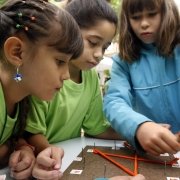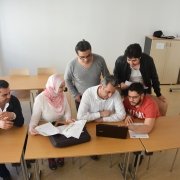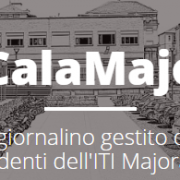Revised Theatre in Education program at ArtEZ University of the Arts, Arnhem
Excerpt
Many art academies in The Netherlands are still very traditional in terms of their student populations and their programs/curricula. The academies are manned by (mostly) white, middle-class students and teachers. The curricula (implicitly) focus on the ideal student, being a talented higher secondary school certificated (‘havo’ or ‘vwo’) middle-class juvenile. This is even more the case at art academies outside the four big cities in the west of the country (and their suburbs).
At ArtEZ in Arnhem (a city in the east of the country), the Theatre in Education program is under revision. Theatre in Education is part of the Academy of Theatre and Dance. Being situated in a not-so-intercultural, highly segregated environment, the program that educates future theatre teachers wants to do something about the aforementioned: change the attitude towards the arts and theatre, and who is entitled to study, be an artist or enjoy the theatre. In short, the program actively wants to open up to other groups than the traditional ones only, and create awareness among its population about the need to “decolonize” and make a connection with society. This means that questions about the definition of art and how it should be judged need to be reconsidered too. As project leader, Mr. Burmania puts it: “If we don’t do this now, we will be irrelevant (and out of a job) soon”.
Narrative, origins and objectives of the initiative
What kind of project is this? Please give a short description (summary) of it.
One of the programs at ArtEZ University of the Arts, Arnhem department (in the east of the country), Theatre in Education, is currently under revision. This process is embedded in a three-year project that involves students and staff. Being situated in a not-so-intercultural, highly segregated city and environment, the program educating future theatre teachers wants to change its attitude towards the arts (in general) and theatre (in particular), and towards who is entitled to study, be an artist or enjoy the theatre. The program actively wants to open up to other groups than the “usual suspects” (white, middle-class, ‘havo’ or ‘vwo’ [=higher secondary school] certificated young people only), and create awareness among its population about the need to “decolonize” and make a connection with present-day society.
The used concept can be summarized as “quality theatre for everyone”. The general idea behind it is that there is an artist in all of us, and that art is not only a matter that should concern certain (privileged) minority groups. This topic also relates to a broad debate in Dutch society about the government subsidies for the arts (should the government subsidize only “highbrow” art or also, or even merely, approachable, popular art and other art forms?). In the new curriculum, students are expected to engage themselves with developments in society, be (pro)active and productive (“the art is in the interaction”).
All this means that traditional definitions of art and how to assess it need to be reconsidered. The project leaders want to replace the idea of the quality standards (based on the Dutch discourse on aesthetics, used to review students’ work and grant marks) by assessing behavioral aspects and the process of making a performance (or a piece of art).
Please tell us why, in general, this project is considered a successful one?
The project involves the entire program and it permanently gains support within the student and teacher populations (and, of course, other employees). The project leader has a clear and innovative vision on art education, one that addresses important present-day issues and (sometimes populist) positions on art (being 'a left-wing elite state-subsided hobby'). The project genuinely inspires and guides most of the stakeholders while the Board of the school is also highly interested in it.
And why would you consider it a grass-roots initiative?
Mr. Cormac Burmania, the project leader and head of the program, has been working as head of a secondary vocational theatre school in Rotterdam for ten years. At school level and in this city (and part of the country), students and staff are much more diverse and integrated (in many ways, diversity is no longer an issue here, but seems merely self-evident). When he started working at ArtEZ HE art school in Arnhem, he took the initiative to improve things at the school, thinking of the students he had in Rotterdam, and how hard it would be for them to move into his new school, find their way here, not being the “ideal students” according to the traditional program, while being (sometimes very) talented at the same time. The group of supporters among the teachers is growing, but most of all, many students are enthusiastic about these thoughts and embrace them to a great extent.
What challenges needed to be solved in this project?
This initiative wants to change the idea that theatre and theatre education at HE-level (mainly EQF 6) as being quite conservative and not open to underrepresented groups in society.
Is this initiative based on any particular theoretical framework? Which one?
This initiative is not based on a theoretical framework in particular.
(Appendix) Is your intervention standing on its own or is it a part of a bigger and more holistic approach?
It is part of a large, 4-year innovation program of the Academy for Theatre and Dance, geared towards becoming a learning community open to a diverse population. Within this community, 5 bachelor programs work on conditions for inclusive education that are interrelated and interdependent. They collaborate in projects like:
- Flexibility of the curricula, necessary to create access to HE to groups and individuals who are not already finding their way to the programs.
- Teachers as coaches, development of feedback skills necessary for a student-centered approach.
- Innovation of assessment procedures, needed to incorporate the value of former (informal) learning in the individual biography of the student.
- Preparatory programs and accessibility.
- Awareness of (a lack of) inclusion as a mindset.
Please describe the group(s) intended as beneficiaries of this initiative
Why has this group (have these groups) been chosen?
The initiative is not directed towards a particular target group; all non-traditional, underrepresented groups are target groups of the project. One could also say that the target group is all students and staff of the program, making them aware of the need to innovate.
Could you please tell us something about the relative size of the (of each) target group, within the school/university population, region and/or country?
Since no specific target group is defined here, this question is hard to answer. The program has about 85 students and wants to recruit more "non-typical" students, create a learning environment for a more diverse population and give them a sense of belonging.
Which social characteristics are taken into account and what is the geographical area covered?
Social characteristics taken into account: everything and everyone that is not “conventional” in the traditional sense of the word; a broader view on “talent” is needed and every member of the community needs to be aware of his or her own perception and norms, and that these are not neutral but a product of their background (culture, ethnicity, gender, social economic status etc.). The geographical area is Arnhem area, The Netherlands.
On which level is the project implemented?
This project is implemented in the Bachelor program of Theatre Education (a program with 85 students)
Please describe the political and socio-economic factors that you believe have been important enablers for your initiative
Did the initiative have political support?
The Dutch government (Ministry of Education, Culture and Science) encourages more diversity in HE, and stimulates the universities (especially in the urbanized western part of the country and its large professional HE organizations) to encourage emancipation and empowerment of underrepresented groups (with stipends, annual reports, etc.). Educational organizations from all over the country are stimulated to cooperate and create pathways for students from underrepresented groups.
How did it fit with local, regional or national policies?
In Arnhem (and, more generally, in this part of the country), topics like inclusive education and intercultural awareness are relatively new, but it cannot be denied that diversity is increasing here too, and that segregation and exclusion are realistic threats. The ArtEZ University of the Arts could be one of the pioneering organizations here.
Who are the stakeholders supporting the initiative?
The project leader, staff of the Theatre in Education program, the whole student community, the academy of Theatre and Dance, the Board of the university and the NCPA (National Center for Performing Arts)
Are there particular demographic changes present that are influencing the project?
This is not the case.
What is the institutional strategy and culture of the (educational) organization?
The innovation funding within ArtEZ is theme-based. Since the autumn of 2017 the theme is Diversity in its broadest concept. As an academy we can apply for innovation funding if the innovation has something to do with diversity. In this way the board gives direction on diversity.
To what extent does the initiative have an influence on institutional policy (or potential influence) of the (educational) organization?
This is not clear yet. A few thoughts:
- Once the (inclusive) pedagogic is developed further there could be a big impact on other courses/programs.
- This initiative contributes to the awareness on diversity and inclusion on different levels, academy, university and national.
(Appendix) Is there public support for your initiative and the issue it addresses?
Within ArtEZ University of the arts, this initiative is the first (and only one) of its kind and, as explained, the composition of the population is still quite traditional in the Arnhem area (while segregation is high). For the most part, a sense of urgency has to be created yet.
(Appendix) What other factors do you think have been important for the success of this initiative?
This question can not be answered yet (hopefully at a later stage)
Please describe the overall initiative design and the methods and tools used to reach the goals
Please describe the specific activities carried out.
One of main “visible” activities is the annual project week with themes related to diversity and inclusion.
In 2017, the theme of the project week was “Cultural Identity”. Prominent guests were invited to talk about and discuss these topics and to stimulate (self)reflection and (self)research. The students created work in studios based on their own cultural identity. Students from Finland and Germany also participated.
In 2018, the project week was about “the power of narratives”, with workshops and presentations; to be continued in studio work. For 2019, the ambition is to organize a more extended project week with more active stakeholders, about embedding the difference. Within the university, connections are being developed to exchange ideas and inspire awareness on the subject of inclusive education.
What were the key roles (teacher, student, management team etc.) within the project?
Key roles include: project leader, program team, expert guests and students.
What ideas, tools, theories, models, methodology (etc.) have been used to reach the goals?
Storytelling, concept of safe space, (indigenous) Concept of Knowledge.
What are the final revenues of the project?
The project is only half-way and it is too early to tell what the final revenues are.
Please describe if your project ensured its sustainability
If so, how did you ensure the short-term impact of the project?
Changing values and awareness on diversity and inclusion is an ongoing process. ArtEZ ensures this by repetition and structural changes in their curriculum design and assessments.
And how did you ensure the long-term impact of the project?
The long-term impact isn’t visible yet: “We are working towards a diverse community within students and staff. We share our findings within the university in order to enhance awareness and knowledge.”
Has your project been replicated elsewhere?
No, not as far as the participants know (hopefully in the near future).
Please tell us about the resources used in this initiative
What was the budget for the initiative?
The initiative was initially financed from the regular educational budget (no extra costs), but for the coming year, it is part of DDD (Denken, Doen en Delen; in English: Think, Do and Share), an innovation trajectory of the academy for Theatre and Dance funded by the “Innovation Fund” of the university. Around €20.000 is reserved for diversity and inclusion.
How much did the initiative depend on volunteers?
This initiative involves and depends on staff and students; not as such on 'volunteers'.
How were the costs perceived by the public/the sector/other stakeholders?
Since costs are very low, there is no need to worry about this.
To what extent did the initiative achieve its objectives?
Please describe the evidence to support the success of your initiative.
The work that students create is strongly influenced by the project weeks. It is clear that there is no return for students in the work they create.
Did the intervention lead to any unintended (positive) outcomes?
There is a new vibe going on in the staff. They are more excited and the community is changing into a learning community instead of a “knowing” community.
What indicators (quantitative and qualitative) have you measured to demonstrate success?
Student population (there is less student failure), diversity of the students’ creations (more diverse work of the students), student initiatives (more initiatives of students can be honored), professionalization of staff (more requests from staff so they can develop with the students).
(Appendix) How did you evaluate/monitor this intervention?
The intervention can be monitored as very promising. Since the program (and learning community) are relatively transparent, a lot can be learned and done within a few years.



 Robinson Henao
Robinson Henao Copyright: Camilla Pellech, Postgraduate Center der Universität
Copyright: Camilla Pellech, Postgraduate Center der Universität

 Robinson Henao
Robinson Henao